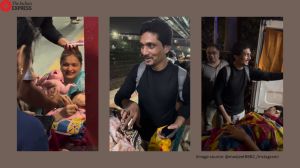Downturn in Dharavi
From inspiring Slumdog Millionaire to putting Asias largest slum on the global tourist map,Dharavis industry and enterprise have spawned a million dreams.
From inspiring Slumdog Millionaire to putting Asias largest slum on the global tourist map,Dharavis industry and enterprise have spawned a million dreams. But this industrial hub is the latest to be hit by the economic crisis. By Kavitha Iyer
Abdul Mannan,30,does not understand what a credit crunch is or how remittances by his eight employees mould the village economy at home in Madhubani,Bihar. But what he knows intimately is a shame he cant shake off. Mein karzdaar hoon, says the father of two who has never taken a bank loan in the 15 years he has spent in Dharavi. And my creditors are my own eight employees.
Mannan hasnt actually borrowed from the youth working for him,but he sunk their last months salaries into uncertainty when he paid his Rs 5,000 rent for February and purchased rations and raw material for the current week. He will pay them if the Bhendi Bazaar store he supplies sequin-embroidered salwar kameez and ghagra choli pieces to places any fresh orders. If their goods dont sell,they wont place orders. And orders have dried up for four months now.
Will he send his men home if things dont improve? Forget my men. I will have to return, he says.
From having inspired a Hollywood blockbuster to putting Asias largest slum on the global tourist map; from its Fendi rip-offs that are for export only to its rags-to-riches tales,Dharavis famed industry and enterprise have spawned a million urban tales of dreams,gumption and bewildering successes. But inside the thumping,clanking and grinding that is the heart of this unlikely industrial hub,Dharavis newest story is that dhanda is mandabusiness has taken a serious hit.
And it is not the poorest of the poor alone who are facing unprecedented job and business crises; more disquieting is the fact that those whose industriousness took them into the middle and upper middle classes through years of hard labour are now in danger of sliding back into poverty.
Ive been set back by three years, says Bhagwandas Prajapati,47,a native of Siddharth Nagar district of Uttar Pradesh,who has been in Dharavi for 33 years. Do you know what that means? It means his savings are wiped out. He owns a house and an industrial unit in Dharavi,but he can call neither an asset right now.
Prajapati arrived in Dharavi as a 14-year-old,started out working as a scrap pheriwallah who collected and sorted plastic waste from ragpickers across the city and delivered them to Dharavis recyclers. He knows no other business,understands nothing of how the stock market crash affects recycling. But Prajapati knows that the plastic firms that bought his recycled plastic are not buying now. He is still purchasing plastic wastecurrently he has batches of PET bottles and syringes whose needles are painstakingly removed before the plastic is ground,washed and sun dried on the second floor roof of his kachcha industrial unit in Dharavis Shakir Compoundand hoping things will pick up. We cant shut shop,right? And,he says,money that has been put into running needs to be at least partly recovered.
The problem is that Dharavi gets no stimulus packages,say Dharavis educated elite. One of these local opinion makers is Fareed Siddique,an urbane business leader in Dharavis 13th Compound area. This shanty-sprawl adjacent to Mahim station alongside Sanaullah Compound and Shakir Compound comprises the hub of Mumbais recycling industry,where plastic,electronic parts,clothes,dyes,chemicals,tin boxes,jerry cans,paper,metal and every other conceivable manner of waste is turned into something saleable.
The recession is the final insult, says Siddiqui,general secretary of the 20-year-old Dharavi Businessmens Association,a group of over 800 members from various industries. For about five months now,demand is down by 50 per cent. We were recycling more than 100 tonnes per day. That is now down to 50 tonnes a day. At least 50 businesses have moved out of Dharavi in the last year, he says,blaming the government for not offering competitively priced electricity. Rent as well as power is cheaper in Vasai and Nallasopara, he says. We pay around Rs 9.50 a unit,as opposed to Rs 4.50 per unit in the far suburbs.
Ahmed Patel,a leading leather goods exporter whose family has been in the business for four generations,says the leather industry has been tottering anyway for several years. Dharavis 60-odd tanneries have all shut down barring a couple; many in the business in the Chamda Bazaar and Kuttiwadi areas of the slum are merely buying skins from the Deonar abattoir and selling them onward to better-supported leather industries in Kolkata,Kanpur and Chennai. The government in Madras assists with research,technical expertise and support in terms of policies. Maharashtras government has never cared, Patel complains.
Another leading leather exporter,Syed Inayat Hussain,says the nearly 90 leather export businesses in Dharavi are barely managing to stay out of the red,working on a no profit,no loss basis. This is a fully export-oriented business, he says. And you know that in long export contracts,the letter of credit is all-important. And now,no foreign importer is willing to give a letter of credit to those exporting finished leather goods like shoes,belts,jackets,handbags,etc from Madras or Calcutta.
Hussain says Ambur,a leather industry hub 175 km from Chennai,which houses tanneries,processing units and goods manufacturing units,has suffered deep losses owing to the global economic gloom. And that has affected our businesses also,since we sell animal skins to them.
In Chamda Bazaar,Farooque Shaikh says he has 500 pieces of buffalo skin,each valued at approximately
Rs 500. Business is over,fully over, he says without emotion. Nobody has purchased anything from us for weeks. When the skins,coated with salt to preserve them,begin to rot after a couple of months,they will be sold at huge losses. But we continue to buy because this is the only business we know. And what if there is a reversal and business looks up again?
In Dharavi,there are no pink slips. Only a few five hundred rupee notes folded into a palm,a few months pay with ticket fare included,and friendly advice: Take an early trip home,return when things look better.
Whether it is Farooque Shaikh in Chamda Bazaar or small scale wallet manufacturer Shamim Sheikh,most enterprises are now taking on only daily wagers. Zari unit owner Mannan and recycling unit owner Prajapati are contemplating sending workers home.
From making Rs 3,000 to Rs 4,000 a week,Mannan now barely sells goods worth Rs 1,500 a week. And neither his
Rs 5,000 monthly rent nor the wages he pays
Rs 100 per labourer per 6-hour tafri or shiftcan be reduced. Returning home is the only honourable option.
Prajapati has heard of less respectable ends. One family committed suicide, he claims. They had taken money on loan and bought several hundred kilos of maal,and there was nothing they could do to make a living or return the money since nobody wanted to buy from them.
That daily wagers are out of work is also obvious from the crowds milling around the chowks all day,sipping chai and waiting for job contractors to show up. In a first,the weekday morning and afternoon shows in Dharavis video parlours are also running full,hundreds of young men watching DVDs of 1980s Bollywood films projected on hazy screens inside musty,darkened rooms smelling of the corner urinal.
Those who employed daily wagers until recently admit that the simplest cost cutting is labour. Inside Shakir Compound,wearing soiled shorts and a vest plastered to his thin frame in the suffocating heat,Wahid Khan is toiling at a drum with a sticky powder that has turned his arms a bright chrome. He is repeatedly rubbing the powder through muslin. His is among 30 units churning out many hundred kilos of what they call chemical powder,dispatched to paint manufacturing companies to be processed further into enamel,acrylic and oil paints.
Apna hi hai, says Wahid,when asked where his boss is. Its his own business,but orders are down by 40 per cent,he says,so hes not employing anybody currently. The price of labour is Rs 300 a day,plus their meals. I only have one order right now,and its just 30 kilos,a few days work that I can do myself, says the Gorakhpur native,adding that business has never been this thanda in his 13 years here.
Across industries,despite the never-before low prices,goods are not moving. Wahids paint powder used to fetch him
Rs 280 a kg,he is now selling at Rs 160 a kg. Prajapatis ground plastic granules fetch him 5 per cent less than his cost price,but hes still willing to sell. Syed Inayat Hussain says a jacket from Calcutta used to fetch an artisan $60,but Chinese jackets are selling at $30 apiece.
Whether the proposed redevelopment will further throw business equations out of kilter is everybodys worry.
On one of our first days in the leather district in Dharavi,we realised that all the Swedish clothing brands manufactured parts of their things here. The same story struck us wherever we looked, says Maria Lantz,Associate Professor at the Department of Art & Architecture of the Royal University College of Fine Arts,Stockholm,Sweden. Lantz is leading a project on documenting change in Dharavi,with a book whose Indian edition is expected soon. We now assume that every person in Europe and the US has something in their homes thats made in Dharavi. That means Dharavis present and its uncertain future are connected to global citizens through merchandise and labour,she says. The proposed redeveloping project affects people who actually work for all of us. As consumers,maybe we should feel responsible too?
Lantz and other researchers are working on several initiatives to turn the spotlight on homegrown business solutions crafted by local communities. As Dharavis buckle export magnate Haji Saeed Idris Khan says,Dharavi sona hai. This land is gold. You only need somebody to understand its value.
For now,however,Dharavi needs somebody to understand its deepening crisis.





- 01
- 02
- 03
- 04
- 05

























